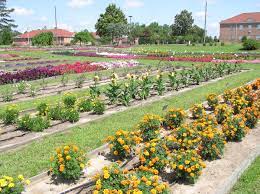
Ornamental Horticulture: Enhancing Beauty and Cultivating Joy
Ornamental horticulture is a captivating branch of gardening that focuses on cultivating and nurturing plants for their aesthetic appeal. It is an art form that combines science, creativity, and a deep appreciation for nature’s beauty. From vibrant flower beds to meticulously designed landscapes, ornamental horticulture enriches our surroundings and brings joy to our lives.
One of the primary goals of ornamental horticulture is to create visually stunning gardens and landscapes. It involves carefully selecting plants based on their colors, textures, shapes, and growth habits to achieve a harmonious composition. Whether it’s a small backyard garden or a grand public park, ornamental horticulturists use their expertise to create visually pleasing environments that captivate the senses.
But ornamental horticulture goes beyond mere aesthetics. It also plays a crucial role in improving our overall well-being. Numerous studies have shown that spending time in beautiful outdoor spaces has a positive impact on our mental health. The sight of colorful flowers, the fragrance of blooming plants, and the tranquility of well-designed gardens can reduce stress levels and promote relaxation.
In addition to their visual appeal, ornamental plants also provide important ecological benefits. They support pollinators such as bees and butterflies, contributing to the overall health of ecosystems. Many ornamentals are also known for their air-purifying properties, helping to improve air quality in urban areas.
Ornamental horticulture encompasses a wide range of practices and techniques. Gardeners may specialize in various aspects such as landscape design, floral arrangements, or maintaining specific types of plants like roses or bonsai trees. They constantly explore new plant varieties, experiment with different combinations, and develop innovative techniques to push the boundaries of what is possible in garden design.
Furthermore, ornamental horticulture encourages a sense of community. It brings people together through gardening clubs, plant societies, and events such as flower shows and garden tours. These gatherings provide opportunities to share knowledge, exchange ideas, and celebrate the beauty of plants with like-minded individuals.
Whether you are an experienced gardener or a beginner with a green thumb, ornamental horticulture offers endless possibilities for creativity and self-expression. It allows us to connect with nature in a meaningful way and create spaces that bring joy to ourselves and others.
So next time you stroll through a beautifully landscaped park or gaze upon a meticulously designed garden, take a moment to appreciate the artistry of ornamental horticulture. It is an extraordinary blend of science and beauty that enhances our lives and reminds us of the wonders of the natural world.
Exploring the Beauty of Ornamental Horticulture: Key Categories, Specialist Roles, Diverse Branches, and the Role of Landscaping
- What are the two major categories within ornamental horticulture?
- What is an ornamental horticulturist?
- What are the four branches of ornamental horticulture?
- Is landscaping a part of ornamental horticulture?
What are the two major categories within ornamental horticulture?
Within ornamental horticulture, there are two major categories: floriculture and landscape horticulture. Floriculture focuses on the production and cultivation of flowering plants, including cut flowers, potted plants, and bedding plants. It involves the art of creating beautiful floral arrangements and providing plants for special occasions, such as weddings or holidays. On the other hand, landscape horticulture involves designing, installing, and maintaining outdoor spaces for aesthetic purposes. It encompasses the creation of stunning gardens, parks, and green spaces that enhance the visual appeal of residential areas, public spaces, and commercial properties. Both categories contribute to the beauty and enjoyment of our surroundings in unique ways.
What is an ornamental horticulturist?
An ornamental horticulturist is a skilled professional who specializes in the cultivation, care, and design of plants for their aesthetic value. They possess a deep understanding of various plant species, their growth requirements, and how to create visually appealing landscapes and gardens. Ornamental horticulturists have expertise in selecting and arranging plants based on colors, textures, sizes, and growth habits to create harmonious compositions. They often work in landscaping firms, botanical gardens, nurseries, or as independent consultants. Their passion for plants and artistic vision allows them to transform outdoor spaces into stunning environments that bring beauty and joy to people’s lives.
What are the four branches of ornamental horticulture?
Ornamental horticulture encompasses four primary branches, each focusing on different aspects of cultivating and beautifying plants. The first branch is floriculture, which involves the production and marketing of flowers and flowering plants. This branch includes growing cut flowers, potted plants, and bedding plants for various purposes like floral arrangements and landscape enhancement. The second branch is landscape horticulture, which concentrates on designing, installing, and maintaining aesthetically pleasing outdoor spaces such as gardens, parks, and public landscapes. The third branch is interior landscaping or interior horticulture, which involves utilizing plants to enhance indoor environments by creating green spaces within buildings. Lastly, nursery production focuses on propagating and growing ornamental plants in nurseries for sale to retail outlets or for use in landscaping projects. These four branches collectively contribute to the diverse realm of ornamental horticulture, allowing individuals to explore different avenues of plant cultivation and design while adding beauty to our surroundings.
Is landscaping a part of ornamental horticulture?
Yes, landscaping is indeed a significant aspect of ornamental horticulture. Landscaping involves the deliberate arrangement and design of plants, trees, shrubs, and other elements to create visually appealing outdoor spaces. It encompasses the art of combining various plants, textures, colors, and structures to achieve a harmonious and aesthetically pleasing environment. Landscapers utilize their knowledge of ornamental horticulture principles to transform outdoor areas into stunning landscapes that enhance the beauty of homes, parks, commercial properties, and public spaces. Through careful planning and implementation, landscaping showcases the artistic potential of ornamental horticulture while creating functional and inviting outdoor spaces for people to enjoy.
